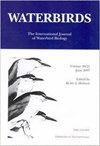Changes in Avian Community Composition at a Restored Floodplain Grassland in the Mekong Delta
IF 0.6
4区 生物学
Q3 ORNITHOLOGY
引用次数: 0
Abstract
Abstract. Reinstating flood pulse dynamics has been identified as a method for restoring biotic communities in altered riverine ecosystems. To explore the impacts of flood pulse management on wet grassland bird communities, we surveyed community composition at a restored floodplain grassland in the Plain of Reeds region of the Mekong Delta. Survey sites were situated at different elevations, allowing us to sample the range of grassland habitats found in the study area. Our surveys coincided with three periods of decade-long water management; two surveys occurred during flood pulse water management, and another followed a decade of year-round high-water management. We used PERMANOVA and NMDS to compare avian community composition between these surveys and used foraging guilds to qualitatively assess the impact of water management separate from turnover in individual species. Community composition differed between all surveys at the lowest elevation site, with detection rates for species associated with ponded water, not grassland ecosystems, highest following high-water management. Some grassland species were absent following high-water management and may have been extirpated from survey sites. In the face of grassland loss across the Mekong Delta, our surveys highlight the value of continued flood pulse management for supporting the conservation of wet grassland birds.湄公河三角洲洪泛平原草地恢复后鸟类群落组成的变化
摘要恢复洪水脉冲动力学已被确定为在改变的河流生态系统中恢复生物群落的方法。为探讨洪水脉冲管理对湿草地鸟类群落的影响,研究了湄公河三角洲芦苇平原恢复后的河漫滩草地鸟类群落组成。调查地点位于不同的海拔高度,使我们能够对研究区域内发现的草地栖息地进行采样。我们的调查恰逢长达十年的水资源管理的三个时期;两项调查是在洪水脉冲水管理期间进行的,另一项调查是在十年的全年高水位管理期间进行的。我们使用PERMANOVA和NMDS来比较这些调查之间的鸟类群落组成,并使用觅食行会来定性评估水管理对单个物种的影响。在低海拔样地,所有调查的群落组成存在差异,在高水位管理下,与池塘水相关的物种检出率最高,而与草地生态系统相关的物种检出率最高。在高水位管理后,一些草地物种缺失,可能已经从调查点灭绝。面对湄公河三角洲的草地损失,我们的调查强调了持续的洪水脉冲管理对支持湿草地鸟类保护的价值。
本文章由计算机程序翻译,如有差异,请以英文原文为准。
求助全文
约1分钟内获得全文
求助全文
来源期刊

Waterbirds
生物-鸟类学
CiteScore
1.30
自引率
0.00%
发文量
0
审稿时长
6-12 weeks
期刊介绍:
Waterbirds is an international scientific journal of the Waterbird Society. The journal is published four times a year (March, June, September and December) and specializes in the biology, abundance, ecology, management and conservation of all waterbird species living in marine, estuarine and freshwater habitats. Waterbirds welcomes submission of scientific articles and notes containing the results of original studies worldwide, unsolicited critical commentary and reviews of appropriate topics.
 求助内容:
求助内容: 应助结果提醒方式:
应助结果提醒方式:


